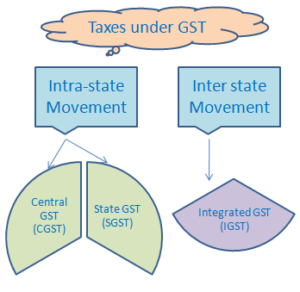Goods & Service Tax (GST) will be levied on goods and services as CGST, SGST & IGST. It will replace all the various taxes and bring them comprised in to make compliance easier. It will replace the following taxes:
| Taxes currently levied and collected by the Centre: | Taxes currently levied and collected by the State: |
|
|
Why are we getting 3 taxes – CGST, SGST & IGST?
India is a federal country where government has assigned the powers to both the Centre and the States to levy and collect taxes. Both the levels of Government have distinct responsibilities to perform, as per the Constitution, for which they need to raise resources. A dual GST will, therefore, be keeping with the Constitutional requirement of fiscal federalism.
The Centre and States will be simultaneously levying GST.
Under GST Law, government will implement 3 taxes to help tax-payers to take credit against each other thus ensuring “One nation one tax”.
http://taxpage.in/one-nation-one-tax.html
 Let’s understand CGST, SGST & IGST:
Let’s understand CGST, SGST & IGST:
The GST to be levied by the Centre on intra-State supply of goods and/or services is Central GST (CGST) and that by the States is State GST (SGST). On inter-state supply of goods and services, Centre will collect Integrated GST (IGST). IGST will also apply on imports. Thus, this IGST will go to the Centre. GST is a consumption based tax i.e. the tax should be received by the state in which the goods or services are consumed and not by the state in which such goods are manufactured. Centre design IGST to ensure seamless flow of input tax credit from one state to another. One state has to deal only with the Centre government to settle the tax amounts and not with every other state, thus making the process easier.
System will first apply any IGST credit to set off IGST then CGST. After that system will apply remaining balance to set off SGST. However, GST is a consumption based tax, i.e., the state where the goods were consumed will collect GST.
Thus, the need for 3 taxes- CGST, SGST & IGST arise to set off credit. All 3 together will serve the purposes of GST namely-
- One nation one tax- so all taxes on all purchases are available as credits.
- Dual tax system- both Centre and states have their revenue.
GST is a completely new tax with new concepts like ‘place of supply’ and new tax structures. GST is applicable in the state where the goods/services are consumed i.e., it is a consumption based tax. This can create confusion with taxpayers can end up paying the wrong type of GST such as paying IGST when they have to pay CGST & SGST. So, the GST law has provisions to address these scenarios. In conclusion, it will take the place of all the numerous taxes and bring them under one umbrella to form recognition easier.
